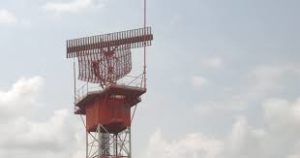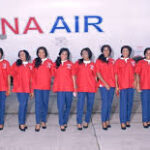
Many Nigerians are anxious while travelling by air in the country. Their anxiety is occasioned by the number of air crashes recorded so far, which experts described as outrageous and tragic, considering the fact that Nigeria has relatively low air traffic. Chinedu Eze writes that government’s efforts to provide more equipment to further improve safety in the airspace should be encouraged.
Many air crashes in Nigeria were attributed to infractions and communication gaps between air traffic control and the pilots and some of them were also caused by bad weather and wrong decisions taken by the pilot. But so far, there have been continuous improvement of communication, navigation and surveillance in Nigeria’s airspace.
The ADC Airlines Flight 086 (ADK086) which crashed into the lagoon on arrival to Lagos airspace from Port Harcourt on November 7 1996 was attributed to air traffic control error because the crew of the Boeing 727.200 operating the flight lost control of the aircraft while avoiding a mid-air collision on approach with Triax aircraft. The aircraft reportedly crashed at a very high speed into the lagoon, killing 144 passengers and crew on board.
Many years ago, a cargo plane owned by Hydro Cargo was made to land on construction site on runway 18R at the Murtala Muhammed International Airport, Lagos. That was November 29 2003. The air traffic control asked the pilot of the aircraft to proceed and land, despite the fact that NOTAM (Notice to Air Men) indicated that the runway was closed for construction. The aircraft landed and was severely damaged. The airline went to court and the Federal Airports Authority of Nigeria (FAAN) and the Nigerian Airspace Management Agency (NAMA) were forced by the court to pay damages to the airline, as the accounts of these two agencies were garnisheed.
Improved Airspace
But since these accidents happened so many changes have taken place in NAMA. Nigeria had established Total Radar Coverage of Nigeria (TRACON), built Aeronautical Information Service and installed other safety critical equipment, including communications equipment that have contributed immensely in improving safety in the airspace.
Recently, the acting Managing Director of NAMA, Mathew Pwajok had a chat with aviation journalists and gave detailed explanations on what the federal government has done to further secure safety in the airspace. The critical areas in airspace management are communication, navigation and surveillance (CNS). CNS/ATM is a popular term in airspace management and it stands for Communications, navigation and surveillance for Air Traffic Management. They use various systems including satellite systems, and varying levels of automation to achieve a seamless global Air Traffic Management system in the airspace.
Pwajok said during the interaction with aviation writers, “On navigation, we have done tremendous investment knowing that most of our navigational facilities have become obsolete. We have virtually replaced all the Instrument Landing Systems (ILS) with a minimum of Category 2 (CAT 2) Instrument Landing System. The category two instrument landing system gives capability approach and landing visibility use up to 300 meters as against category one that requires about 800 meters for approach and landing.
“At the moment, we have done category two instrument landing system in over 10 airports. We have done on the domestic runway of Lagos 18L. We have done in Benin, two instrument landing systems are actually installed in Benin on both runways, even on runway 23,” Pwajok said.
The NAMA boss also disclosed that new ILS installed in Enugu, another new one (ILS CAT 2) in Maiduguri, in Sokoto, in Abuja (in runway 04), just as category 3 was installed on runway 22 of Abuja airport and Lagos runway 18R. NAMA has also installed category 2 ILS in Yola, in Sokoto, in Jos, in Minna, in Akure, in Ilorin and others.

Instrument Landing System
Instrument Landing System is a safety critical equipment, which is a standard International Civil Aviation Organisation (ICAO) precision landing aid that is used to provide accurate azimuth (an azimuth is an angular measurement in a spherical coordinate system) and descent guidance signals for the guidance to aircraft for landing on the runway under normal or adverse weather conditions. The higher the category of ILS the higher the visibility, Category 3 ILS will enable the pilot to see clearly with decision height lower than 100ft (30 meters) and runway visual range of not less that 700ft (200 meters).
“We are installing additional 3 category 3 instrument landing systems in Katsina, in Kano, and in Port Harcourt in addition to Lagos and Abuja that are operational. So for navigation, we have Doppler VOR (Voice Omnidirectional Radio Range), Doppler Very High Omni Directional Radio rate navigational guidance facility in over 10 airports as well. That also includes Maiduguri, we did Kano, we did Jos, we did Yola and we did Minna. We have also done Lagos, Benin. We have done Akure, we have done Ilorin and we have also done Jos. There are over 10 airports with brand new Doppler VOR, which have the capability for aircraft guidance within the country. We are still ongoing with the deployment of new systems of navigation to enhance access to our airports and enhance en-route navigation nationwide.
Satellite Based Navigation
Pwajok said NAMA has also installed satellite-based navigation, provided a backup system for the conventional navigation or navigation based on ground systems; so what NAMA has done in the four international airports is to install what is called Performance Based Navigation (PBN) approach on both sides of the runway to provide backup in the event of a failure in any of the ground navigational systems.
Performance-based Navigation (PBN) is said to redefinesthe aircraft’s required navigation capability from sensor (equipment) based to performance based. The foundation for Performance Based Navigation is area navigation or RNAV.
Pwajok said the satellite system is used with the GPS (Global Positioning System) to approach and land in any runway.
“We have done over 32 airports and that included all the federal airports, basically all the states airports. I think the only airport that we have not done this navigation in Nigeria will be Jalingo airport. That has to do with some issues of lack of survey for Jalingo airport in Taraba. Otherwise, we have done performance-based navigation in all the Nigerian airports, including Zaria (Nigeria College of Aviation Technology (NCAT), including the airstrip at Eket; including a military airport in Port Harcourt and a military airport in Makurdi. We are currently working with the Nigerian Air Force to assist them also in Satellite Navigation in Kaduna military airport.
“We have done the survey, we are currently developing the procedures to ensure that any airport in Nigeria can be accessed using ground based navigational facilities or satellite based navigational facilities to increase access with these facilities in these airports. On navigation recently we implemented what we call Free Routing Airspace (FRA) in Nigeria. This is the first time in the whole of continental Africa that this concept is implemented.
“This is a new concept and the benefits it gives to airspace users is that, pilots or aircraft for airsides are able to fly a shorter route in shorter flight time reducing fuel consumption, reducing flying time, reducing distance flown, reducing Co2 emissions and reducing pilot work load. This has put Nigeria above a few countries that have been able to do this. Aircraft takes advantage of the wind direction, wind speed, fly shorter distance within our airspace following the implementation of the Free Routing Airspace, which is a newer concept aimed at assisting airlines during the coming recovery to enhance occasional efficiency globally,” the NAMA boss explained.
Surveillance
On surveillance, Pwajok said that NAMA has made some advancement in providing equipment and facilities that enhance surveillance in Nigeria’s airspace.
The concept of surveillance is to have a sensor (or a network of sensors) that detects aircraft, calculates their position, obtains other data (such as identification, level, etc.) and then present it to the controller on a situation display. This is what TRACON, which was built 10 years ago does. It captures the aircraft in the air, provides other information and data needed. But while TRACON has captured Nigeria’s airspace, there are lower areas the radar cannot capture, hence multilateration, which is decribed as a technique for determining a “vehicle’s” position based on measurement of the times of arrival of energy waves traveling from or to multiple system stations having been synchronized. Putting it simply, the objective for the installation of multilateration in the Niger Delta area by NAMA is to capture low flying aircraft like helicopters that operate in the region and other regions in proximity. This is very critical for safety purposes.
“On surveillance, like I mentioned earlier, we were in Port Harcourt over a project geared towards wide area lateration for low flying helicopters in the Gulf of Guinea. It is a project we started with the Federal Executive Council in October in 2018. We are in the process of concluding this project, we have to have a stakeholders’ sensitization to get the buy in, understanding of further cooperation of the operators. The surveillance system or the air-land system is for low flying helicopters. And the beauty of this new concept, or new surveillance capability we are inheriting, is that it is to capture low flying helicopters that have increased within the Niger Delta area. And knowing the strategic nature of this sector, is its strategic nature in the economy; so we had to implement the surveillance system that will enhance the efficiency of low flying helicopters in that region.
“We incorporated what we call also the UTN system, which is unmanned aircraft system traffic management system. That is the surveillance and air traffic management that can detect drones or what is being referred to as remotely piloted aircraft systems or unmanned aircraft systems or unmanned area vehicles. We will be able to monitor them and control them within the entire Niger Delta. So it is part of the multilateration project, because we have low flying drone and also low flying manned aircraft or helicopters within the sector. Most of these low flying aircraft are carrying out some duties either logistics supplies or carrying out pipeline monitoring or inspections or also carrying out security surveillance within the Niger Delta. So this lateration project provides the opportunity for surveillance or monitoring or control of both manned aircraft and unmanned aircraft operating within that area and exploration activities,” Pwajok explained.

He said in the area of surveillance that it is one of the key projects that has reached probably 80 per cent implementation. He also explained that the moment the equipment is being installed, the transmitters, receivers are spread over 29 locations covering the entire Niger Delta. And the system would be centralised in Port Harcourt in three sectors to cover the entire Niger Delta.
“In surveillance also we are currently doing an upgrade of the Total Radar Coverage of Nigeria, the TRACON project. The project as you well know was commissioned in 2010 October and since then we have not been able to do an upgrade. So we are upgrading the system to what we refer to as Top Sky Radar System, to improve on the functionality of the system, improve on the efficiency of the system and also increase air traffic management capacity. The system will come automated as against what we currently have, where air traffic controllers drive the traffic manually. With upgraded system, which we are going to do, they will have the capacity to use electronic drive progress. That will reduce workload on the air traffic controllers and reduce pressure on the pilots and it becomes digital functionalities that will avail the air traffic controllers with additional information that they don’t need to ask the pilot. Information that can be extracted automatically and this will be included in the system to reduce the pressure on both sides.
It will also reduce voice communication, congestion by air traffic controllers asking pilots for certain information like aircraft type, registration, operating company, nationality, persons on board. These are all the information the air traffic controllers try to get to be able to give statistics in the industry. With the upgrade of this system, most of these data, if not all, will be available automatically and reduce the pressure of asking the pilot for all these kind of information. The upgrade of the system will be in the nine radar sites covering the entire Nigeria. These sites are in Lagos, Kano, Abuja, Port Harcourt, Ilorin, Maiduguri, Talata Mafarawa, Obubra; nine locations where we have the total coverage. It will be hardware and a software upgrade. The project is already in progress and we have to increase to improve safety, efficiency and capacity of the air traffic management system. In surveillance also, we have done the automatic dependence surveillance contract covering the entire airspace using satellite surveillance. We are also planning to implement what we call Space Based Automatic Dependence Surveillance Broadcast, other layer of surveillance that will enhance the total coverage as a backup, the ground radar system in line with ICAO requirement for ensuring redundancy in every system that we implement,” he stated.






